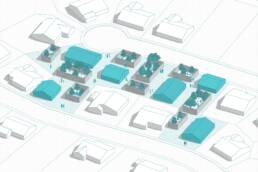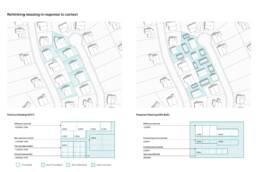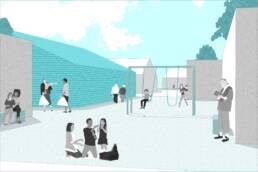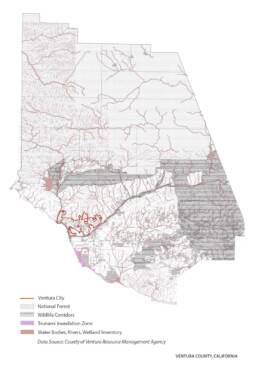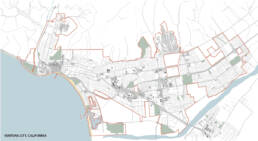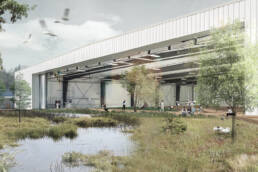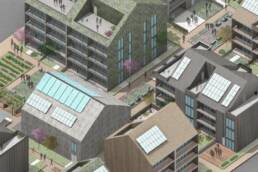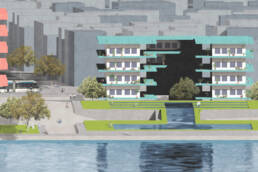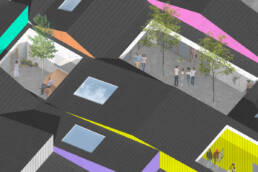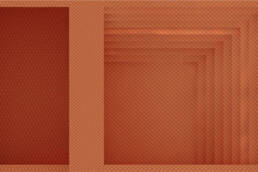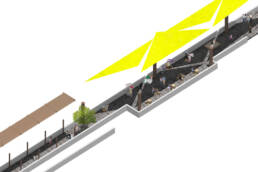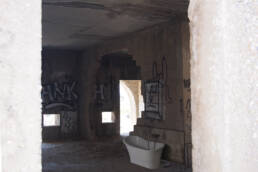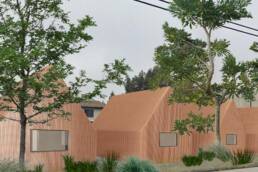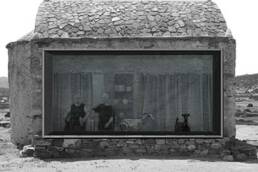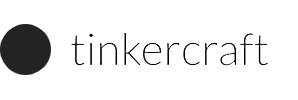
SOUTHERN CALIFORNIA WILDFIRES: FROM CITIZEN SCIENCE TO CITIZEN DESIGN
The proposal shown here is the result of a collaboration with local homeowners at Ventura County. Stakeholders expressed interest in rebuilding through small-scale common ownership by grouping 6-8 lots together. Building using stone or concrete, at times wrapped with metal shingles, eliminates the need for setbacks and therefore opens up the opportunity to build as needed, when needed, in an ad-hoc manner. Landscaping is wrapped in concrete enclosures, offering both solitary areas of contemplation and larger ecosystems, each box a possibility for a distinct habitat and a place to reastablish a lost tradition of interaction and experimentation with fire.
Wildfires are perceived as climate threats, much like earthquakes, sea level rise, and other extreme weather events. But where recent resilience proposals for coastal cities in the United States, notably those in New York proposed through the Rebuild by Design competition and those in the San Francisco Bay Area proposed through the Resilience by Design competition, envision new landscape infrastructures that absorb, rather than deflect and defend against, storm surges and sea level rise, how to build ecologically in wild-urban interfaces is a question devoid of answers.
It is also a question that is rarely even posed, in part because the invention of public lands in North America displaced agricultural and settler use of fire, as well as the experimental nature of people’s relation to fire and the resources around them (Pyne). These practices that were virtually eradicated with the emergence of the industrial revolution, which brought with it a fundamental shift in the way we perceive fire. Scholars Nigel and Yusoff describe it as a move “towards fossil-fueled internal combustion in the light of a much longer human history of broadcast burning of vegetation and of artisanal pyrotechnologies” (2014). Where fire was historically understood as a natural resource whose role in ecosystem processes was fundamental, an agent that transformed materials through an extraordinary synergy with the atmosphere and life form, as of the industrial revolution it was conceived as a carboniferous material to be enclosed and contained within a closed loop of internal combustion (Nigel and Yusoff 2014). Open fires, whether in the home or outside of it, were a source of danger in need of containment and regulation. It is through fire’s isolation and enclosure that we are able to, quite literally, fuel civilization insofar as the mechanics of fire are used to convert chemical energy into thermal energy across repeatable, disembodied, and tightly-controlled processes (Mitchell 2011).
The annihilation of the use of open-ended experimentation with fire led to the prevailing forestry management practice of fire suppression, which is only recently challenged with controlled burning. When fire suppression became a legitimized tool, supported by the state, in forest management practices at the start of the 20th century, not only were ecosystems degraded but Native American communities were further marginalized, labeled as primitive in their insistence on fire as a mediator with land (Anderson 2006). In the words of Stephanie LeMenager, “both the scaling up of megafires into firestorms with their self-generated weather and the greater likelihood of megafires themselves are the products and the effects of colonization” (2018).
The relationship between profit and risk in southern California’s exurban land is fraught. To understand how the aspiration towards resilience implicates the act of governance and the management of land, this line of research examined the 2017 wildfires in the Ventura and Santa Barbara Counties of southern California. In the effort to generate resilient landscapes, ones that can withstand and contain sudden and severe wildfires, state institutions call on individual homeowners. Local government agencies and organizations, limited in their capacity to regulate large-scale land strategies because of strong private property laws, have to rely on the individual homeowners to transform their homes and land in a way that can safeguard themselves and their communities, and the capital embedded in these systems, from wildfire damage. Setbacks, shrub clearings, fire-retardant building materials, fire-resistant vegetation, and distributed water retention ponds, among other, are tools that are deployed on a household-by-household basis, transforming citizens into facilitators and casting domesticity onto the public policy realm.
–
Anderson, K. M. “The Use of Fire by Native Americans in California” in Fire in California’s Ecosystems, edited by Neil G. Sugihara, Jan W. van Wagtendonk, Kevin E. Shaffer, Andrea E. Thode, JoAnn Fites-Kaufman. P417-430. Berkeley: University of California Press.
Clark, N. and Yusoff, K. 2014. “Combustion and Society: A Fire-Centred History of Energy Use,” in Theory, Culture & Society V.31(5), p.203-226.
LeMenager, S. 2018. “Living with Fire (Hot Media).” e-flux architecture, Accumulation series. Accessed on 09.10.2018 (https://www.e-flux.com/architecture/accumulation/212491/living-with-fire-hot-media.)
Mitchell T. 2011. Carbon Democracy: Political Power in the Age of Oil. London: Verso.
Pyne, S. J. 1997. America’s Fires: Management of Wildlands and Forests. Durham, North Carolina: Forest History Society.
